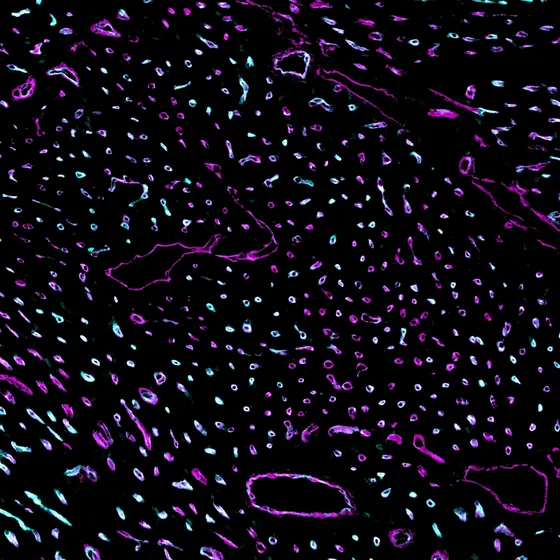One of the main causes of type 2 diabetes mellitus is insulin resistance. The functions of the pancreatic hormone insulin include enabling glucose to be transported from the blood to the muscle cells. Thus the cells are supplied with glucose, an important source of energy, and at the same time the blood sugar level drops. Insulin resistance, a pre-stage of diabetes, is a condition in which the tissue is not able to respond to insulin appropriately and to absorb sugar. If this condition persists, the pancreas begins to produce an increasing amount of insulin, but the blood sugar level continues to rise. If the pancreas is unable to cope, this leads to a relative lack of insulin. Obese individuals are particularly at risk here.
The exact mechanisms behind insulin resistance have not yet been fully explained. Scientists from the German Cancer Research Center (DKFZ) and from Heidelberg University Hospital and University Medicine Mannheim have now established that the endothelium – the cell layer that lines the inside of the blood vessels – may play an important role. “That would seem likely, because insulin needs to cross this layer when it is transported from the blood to the muscle cells,“ explained Andreas Fischer, a DKFZ scientist and a physician at Heidelberg University Hospital.
Fischer and his team are investigating the signaling pathways that regulate the transport of nutrients, hormones, immune cells, and cancer cells through the vessel walls. They are focusing particularly on what is known as the Notch signaling pathway. Endothelial cells stimulate this molecular communication channel so that fatty acids can pass through the cell layer. Fischer examined what happens in mice if there is a surplus of fatty acids, as there is for example in chronic obesity.
The researchers found that the Notch signaling pathway is more active in obese rodents than in normal-weight mice. Moreover, the obese mice were less sensitive to insulin and had a higher blood sugar level.
To determine whether Notch really plays a key role here, Fischer and his team examined specially bred mice in which the Notch signaling pathway is permanently active. The scientists did in fact find insulin resistance and an increased blood sugar level even in young, slim, and apparently healthy animals. However, when they blocked Notch, even animals that were fed an extremely fatty diet did not develop insulin resistance.
In addition, the researchers established that Notch activation prevents 'caveolae' from forming in the endothelium. Caveolae are tiny, sack-like invaginations of the plasma membrane that are responsible for transporting insulin molecules through the cell membrane, among other things.
“The Notch signaling pathway thus directly controls insulin transport through the vessel wall, and permanent activation leads to insulin resistance,“ Fischer explained, summarizing the results. This finding makes a key contribution to gaining a better understanding of metabolic syndrome – and to finding out how obesity and a high-calorie diet lead to type 2 diabetes.
Notch cannot simply be deactivated in patients to stimulate insulin uptake again, however. As Fischer already established previously, the Notch signaling pathway is responsible for fatty acids reaching the cardiac muscle cells. Fatty acids are the heart's main source of energy. Notch blockage can therefore cause cardiac insufficiency.
“We assume that Notch is a kind of switch and that there is a balance between the active and inactive states of the signaling pathway under normal physiological conditions in a healthy organism,“ Fischer remarked. The goal now is to find out what disrupts this balance in obese individuals.
Hasan, SS, Jabs M, Taylor J, Wiedmann L, Leibing, T, Nordström V, Federico G, Roma LP, Carlein C, Wolff G, Ekim-Üstünel B, Brune M, Moll I, Tetzlaff F, Gröne HJ, Fleming T, Cyrill Géraud C, Herzig S, PP, Fischer, A: Endothelial Notch signaling controls insulin transport in muscle. EMBO Molecular Medicine 2020, DOI: 10.15252/emmm.201809271
A photo for the press release is available at:
https://dkfzcms.inet.dkfz-heidelberg.de/de/presse/pressemitteilungen/2020/bilder/Fischer_Caveolae.jpg
Photo caption: Caveolae (cyan) in blood vessels (magenta) of the cardiac muscle.
Note on use of images related to press releases
Use is free of charge. The German Cancer Research Center (Deutsches Krebsforschungszentrum, DKFZ) permits one-time use in the context of reporting about the topic covered in the press release. Images have to be cited as follows: “Source: Iris Moll/DKFZ.
Distribution of images to third parties is not permitted unless prior consent has been obtained from DKFZ's Press Office (phone: ++49-(0)6221 42 2854, E-mail: presse@dkfz.de). Any commercial use is prohibited.



